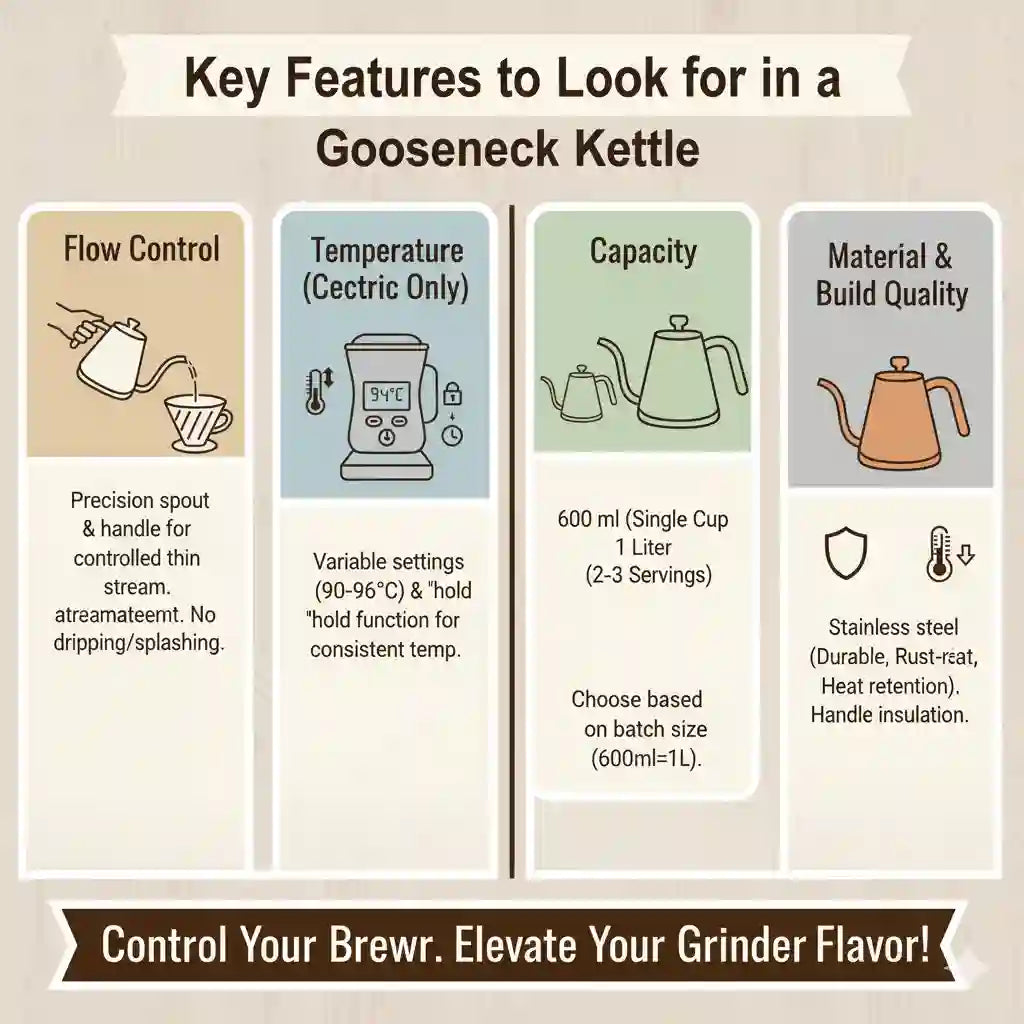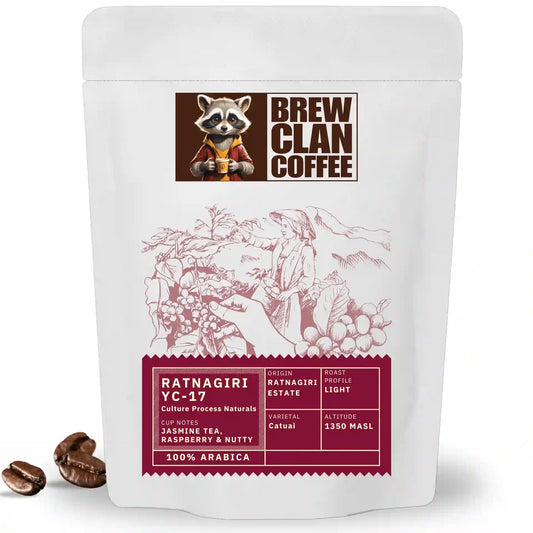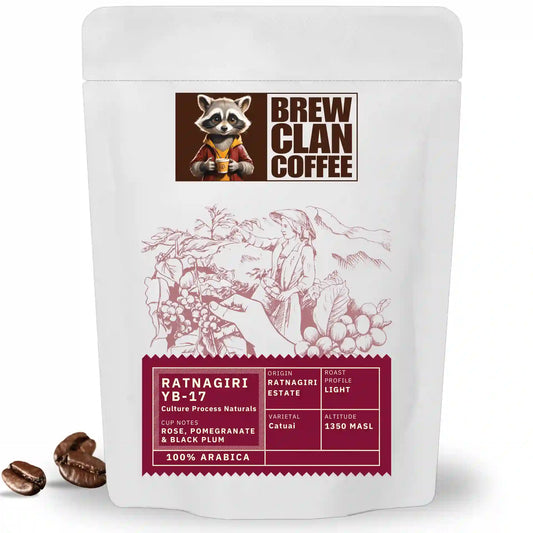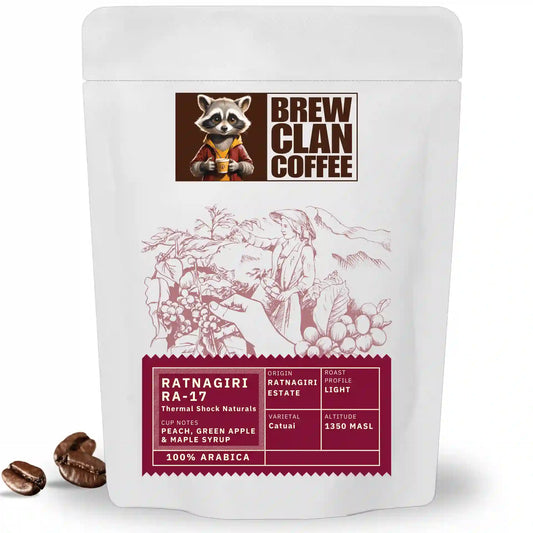
Choosing the Right Gooseneck Kettle for Perfect Pour-Over
Share
If you’ve fallen in love with pour-over coffee, you’ve probably realized it’s as much an art as it is a science, and your kettle is a big part of that equation.
Unlike a standard kettle, a gooseneck kettle gives you precise control over the speed and direction of your pour, helping you hit every part of the coffee bed evenly for balanced extraction and better flavor.
But with so many gooseneck kettles out there, choosing the right one can feel overwhelming. Should you go electric or stovetop? Do you need temperature control? How big should it be?
In this guide, we’ll break down what to look for in a gooseneck kettle, so you can confidently pick one that fits your brewing style and helps you make your best pour-over coffee yet.
Why a Gooseneck Kettle Matters for Pour-Over
Pour-over coffee is all about control: the speed, direction, and consistency of your pour affect how evenly coffee grounds are saturated, which in turn shapes extraction, flavor, and balance in your cup.

That’s where a gooseneck kettle makes all the difference.
Precision Pouring
The narrow, curved spout of a gooseneck kettle allows you to pour slowly and accurately, so you can control exactly where and how much water hits the coffee bed.
Even Saturation
A steady, controlled pour ensures all coffee grounds bloom and extract at the same rate, preventing channeling (uneven water flow that leads to sour or bitter spots).
Repeatable Results
Using a gooseneck helps you pour the same way every time, leading to consistent brews, essential for refining your recipes and getting predictable flavors.
In contrast, pouring from a regular kettle often causes water to gush too quickly or unevenly, making it harder to brew balanced, delicious coffee.
Electric vs. Stovetop Gooseneck Kettle: Which Is Right for You?
One of the first decisions when choosing a gooseneck kettle is whether to go electric or stovetop.

Both can make excellent pour-over coffee, but each has its strengths depending on your brewing habits and setup:
Electric Gooseneck Kettles
- Ideal for home brewers who want precise temperature control, fast heating, and convenience.
- Many electric models offer variable temperature settings, letting you dial in the exact brewing temp for different coffee types (e.g., 92–96°C).
- Features like auto shut-off, keep-warm functions, and digital displays make them easy to use.
- Require access to an electrical outlet.
Stovetop Gooseneck Kettles
- Perfect for minimalists or those who prefer a classic approach.
- No need for electricity, great for gas, induction, or other stovetops.
- Simpler, often more durable designs with fewer parts that can fail.
- Lack precise temp control, so you’ll need a separate thermometer if you want accuracy.
Which should you choose?
If you value speed, precision, and convenience, go electric. If you like simplicity, portability, or don’t mind manual temperature checks, stovetop kettles can be a great, reliable option.
Key Features to Look for in a Gooseneck Kettle

When comparing gooseneck kettles, focus on these essential features to ensure you get the control, convenience, and durability you need:
Flow Control
- The design of the gooseneck spout and handle ergonomics determine how easily you can pour slowly, evenly, and precisely.
- Look for a spout that allows a controlled, thin stream without dripping or splashing.
Temperature Control (Electric Only)
- Variable temperature settings let you heat water to the ideal range for different coffee types (typically 92–96°C for most pour-overs).
- A kettle with a “hold” function keeps water at your set temp, giving you flexibility during prep.
Capacity
- Standard gooseneck kettles for home use range from 600 ml to 1 liter.
- Choose based on your batch size: smaller for single cups, larger if you regularly brew for 2–3 people.
Material & Build Quality
- Stainless steel kettles are durable, resistant to rust, and maintain heat well.
- Copper or brass options offer style but may require more maintenance.
- Pay attention to handle design and insulation to avoid burns.
Speed & Stability (Electric Only)
How quickly the kettle heats water and how accurately it maintains the set temperature affect convenience and brew consistency.
Prioritize kettles that balance these specs within your budget, focusing on precise pouring and temperature accuracy, the two biggest factors that impact your pour-over quality.
Optional but Helpful Features
While not critical, these additional features can make your brewing routine smoother and more enjoyable, especially if you’re looking to perfect your pour-over technique:
Built-in Timers
Some kettles include a timer on the base or handle, letting you easily time your bloom and pour phases without a separate device.
Temperature Display
LCD or analog readouts give you instant feedback on your water temperature, adding confidence to your brews, especially if you’re experimenting with recipes.
Temperature Hold Function
Maintains your set temperature for a specific time (e.g., 30–60 minutes) so you don’t need to reheat between multiple brews or if you’re multitasking.
Auto Shut-Off
Adds safety and peace of mind, turning off the kettle when the water reaches your target temp or if it’s left unattended.
Swivel Base (Electric Models)
Allows the kettle to rotate 360° on its base, making it easier to pick up and set down from any angle.
These features aren’t must-haves, but they can make your pour-over process more precise, efficient, and enjoyable, especially if you brew often or want to refine your technique.
Practical Tips for Choosing Your Kettle
Buying a gooseneck kettle is an investment in better coffee, but you don’t need to overspend or get features you won’t use. Here’s how to choose smart:
Set a Budget First
- Entry-level stovetop goosenecks can start affordably, while high-end electric models with precision features cost more.
- Decide what you’re willing to spend, then focus on kettles offering the best spout control and build quality in your range.
Match Capacity to Your Brewing Style
- Single-cup drinkers may prefer smaller kettles (600–800 ml) for easier handling.
- If you brew for family or guests, consider larger models (1 liter or more) to avoid reheating.
Think About Brewing Location
- If you often brew in different places or lack kitchen counter space, a stovetop kettle can be more flexible.
- For consistent home brewing near an outlet, electric kettles add convenience with fast, precise heating.
Test Ergonomics When Possible
- If you can handle the kettle in-store or read reviews, check that it feels balanced and comfortable in your hand.
- A comfortable grip helps you pour steadily and reduces wrist fatigue during longer pours.
Don’t Overcomplicate It
Fancy features are great, but for most home brewers, a kettle with a good spout, solid build, and comfortable handle will dramatically improve your pour-over results.
To Conclude
A gooseneck kettle isn’t just a fancy accessory, it’s a powerful tool for achieving precision, consistency, and balanced flavors in your pour-over coffee.
By focusing on features like flow control, temperature accuracy, and ergonomic design, you’ll find a kettle that helps you brew with confidence and bring out the best in your beans.
Remember: Great coffee starts with great beans. At BrewClan, we roast specialty-grade coffees in small batches, so your perfect pour-over tastes fresh, vibrant, and exactly how you want it.
Give our beans a try once, and you’ll taste the difference, no convincing needed.
Explore BrewClan’s Specialty Coffee →
FAQs - Frequently Asked Questions
1. Do I really need a gooseneck kettle for pour-over coffee?
While not mandatory, a gooseneck kettle gives you precise control over flow rate and direction, which helps extract coffee evenly and improves flavor.
2. What’s better: electric or stovetop gooseneck kettle?
Electric kettles offer fast heating and precise temperature control; stovetop models are simpler, more portable, and don’t require electricity.
3. How big should my gooseneck kettle be?
For single-cup brewing, 600–800 ml is ideal. For brewing multiple cups, choose a kettle closer to 1 liter.
4. Why does spout shape matter in a gooseneck kettle?
A narrow, curved spout allows slow, even pouring, ensuring all coffee grounds are saturated evenly for balanced extraction.
5. Do I need a variable temperature kettle for pour-over?
It’s not required, but variable temperature control helps you dial in precise water temps (usually 92–96°C) for better consistency.
6. Are gooseneck kettles worth it for beginners?
Yes, they make learning pour-over techniques easier by giving you control over your pour, leading to better-tasting coffee even if you’re new.




